Potřebujeme váš souhlas k využití jednotlivých dat, aby se vám mimo jiné mohly ukazovat informace týkající se vašich zájmů. Souhlas udělíte kliknutím na tlačítko „OK“.
ASTM D6093-97(2011)
Standard Test Method for Percent Volume Nonvolatile Matter in Clear or Pigmented Coatings Using a Helium Gas Pycnometer
Automaticky přeložený název:
Standardní zkušební metoda pro procenta Volume energeticky nezávislé věci, v čiré nebo pigmentované nátěry pomocí Helium Pyknometr
NORMA vydána dne 1.6.2011
Informace o normě:
Označení normy: ASTM D6093-97(2011)
Poznámka: NEPLATNÁ
Datum vydání normy: 1.6.2011
Kód zboží: NS-33745
Počet stran: 3
Přibližná hmotnost: 9 g (0.02 liber)
Země: Americká technická norma
Kategorie: Technické normy ASTM
Kategorie - podobné normy:
Anotace textu normy ASTM D6093-97(2011) :
Keywords:
coatings, helium gas pycnometer, paint film density, coverage, percent volume nonvolatile matter, VOC, volatile organic compound content, Volatile organic compounds (VOC)--paints/related coatings, Coatings, Helium pycnometer method, Nonvolatile matter content, Paint film density, Percent volume nonvolatile matter, ICS Number Code 25.220.01 (Surface treatment and coating in general)
Doplňující informace
| Significance and Use | ||||||||||||||
|
This test method measures the volume of dry coating obtainable from a given volume of liquid coating. This value is useful for calculating the volatile organic content (VOC) of a coating and could be used to estimate the coverage (square feet of surface covered at a specified dry film thickness per unit volume) obtainable with different coating products. Note 1—In Practice D3960 paragraph 10.3.1, the equation for calculating the VOC content using the percent volume nonvolatile is given. Prior to this method a satisfactory procedure for measuring percent volume nonvolatile did not exist (see Note 11 in Practice D3960). Note 2—Since the actual coverage of a coating includes the void volume and the porosity of the film, the coverage value calculated from this method will be inaccurate by that amount, that is, the actual coverage will be greater. The higher the pigment to binder ratio (P/B) of a coating or the higher content of void containing material (latices, hollow beads, etc.) or both, the greater will be the deviation of the coverage calculation (This is also true to a lesser degree with Test Method D2697). For various reasons the volume nonvolatile value obtained for a coating is often not equal to that predicted from simple linear addition of the weights and volumes of the raw materials in a formulation. One reason is that the volume occupied by a solution of resin in solvent may be the same, greater, or less than the total volume of the separate ingredients. Such contraction or expansion of resin solutions is governed by a number of factors, one of which is the extent and direction of spread between solubility parameters of the resin and solvent. The spatial configuration of the pigment particles and the degree to which the pigment particles are filled with the binder also affect the volume of a dry coating film. Above the critical pigment volume concentration, the apparent volume of the dry film is significantly greater than theoretical due to the increase in unfilled voids between pigment particles. The use of volume nonvolatile matter values in such instances should be carefully considered as the increased volume is largely due to air trapped in these voids. For thin films, the issue of critical pigment volume effects is usually not a concern. With high poly(vinyl chloride) (PVC) films, however, liquid displacement of air voids takes place with difficulty even under high pressures. Helium solves this problem since, as a gas, it readily penetrates and displaces air, water, and volatile solvents even at low pressures. Purging the gas pycnometer flushes these materials from the film. |
||||||||||||||
| 1. Scope | ||||||||||||||
|
1.1 This test method covers the determination of the percent volume nonvolatile matter of a variety of clear and pigmented coatings. The approach used should provide faster and more accurate results than the use of the liquid displacement technique in Test Method D2697, particularly for coatings that are difficult to wet or that contain voids, cracks or other defects. The improvement in accuracy stems from the superior ability of helium gas under pressure to penetrate very small pores and surface irregularities in dried films. This provides a more accurate determination of void volumes than can be obtained via liquid displacement. 1.2 The technique will provide results under the following constraints: 1.2.1 The stability of the helium gas pycnometer is greater than ±0.005 cm3 1.2.2 Test specimen weights are greater than 1 g. 1.3 The values stated in inch-pound units are to be regarded as standard. The values given in parentheses are mathematical conversions to SI units that are provided for information only and are not considered standard. 1.4 This standard does not purport to address all of the safety concerns, if any, associated with its use. It is the responsibility of the user of this standard to establish appropriate safety and health practices and determine the applicability of regulatory limitations prior to use. |
||||||||||||||
| 2. Referenced Documents | ||||||||||||||
|
Podobné normy:
Historická
1.8.2014
Historická
1.11.2013
Historická
1.4.2011
Historická
1.5.2012
Historická
1.8.2013
Historická
1.11.2007


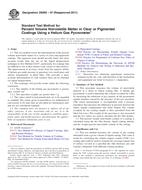
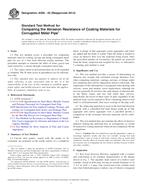 ASTM A926-03(2014)..
ASTM A926-03(2014)..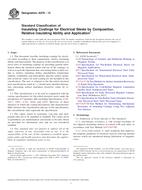 ASTM A976-13
ASTM A976-13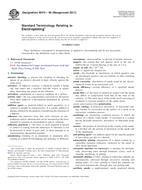 ASTM B374-06(2011)..
ASTM B374-06(2011).. ASTM B418-12
ASTM B418-12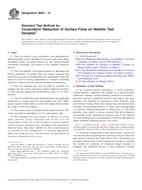 ASTM B825-13
ASTM B825-13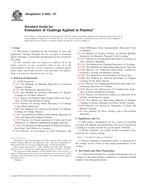 ASTM D3002-07
ASTM D3002-07
 Cookies
Cookies
